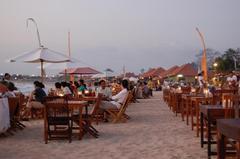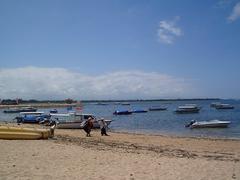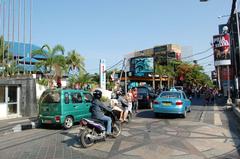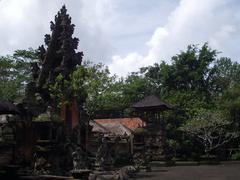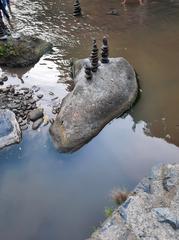
Comprehensive Guide to Visiting Honeymoon Beach, Denpasar, Indonesia
Publication Date: 19/07/2024
Introduction to Honeymoon Beach
Honeymoon Beach, nestled in the vibrant city of Denpasar, Bali, Indonesia, is a destination that seamlessly blends natural beauty, historical richness, cultural depth, and economic vitality. This picturesque beach is not merely a haven for honeymooners but a location steeped in history and tradition. Originally gaining prominence during the Dutch colonial period in the early 20th century, Honeymoon Beach has evolved into a symbol of peace, love, and relaxation. Its significance extends beyond its romantic allure, playing a vital role in the local Balinese community’s spiritual and cultural practices. Ceremonies such as Melasti, a sea purification ritual, highlight the beach’s sacred status among the Balinese people. Economically, Honeymoon Beach is a cornerstone of Bali’s thriving tourism sector, drawing thousands of visitors annually, which in turn supports local businesses and infrastructure development. However, the influx of tourists brings environmental challenges that necessitate sustainable practices to preserve this natural gem (Bali Tourism Board). This comprehensive guide aims to provide travelers with essential information, travel tips, and insights into the cultural and historical context of Honeymoon Beach, ensuring a memorable and respectful visit.
Table of Contents
- Introduction
- Historical Background
- Cultural Significance
- Economic Impact
- Environmental Considerations
- Visiting Information
- Special Events and Photography Spots
- Conclusion
- FAQs
Historical Background
Honeymoon Beach, located in Denpasar, Bali, Indonesia, has a rich and multifaceted history that intertwines with the broader historical narrative of Bali. The island of Bali itself has been inhabited since prehistoric times, with evidence of human activity dating back to the Paleolithic era. The island’s history is marked by the influence of Hinduism and Buddhism, which arrived from India around the 1st century AD. This cultural infusion is evident in the numerous temples and historical sites scattered across Bali, including those near Honeymoon Beach.
The beach gained its name during the Dutch colonial period in the early 20th century. It was a popular spot for newlyweds and romantic getaways, hence the name “Honeymoon Beach.” The Dutch influence is still visible in some of the architectural styles and cultural practices in the area. During World War II, Bali was occupied by Japanese forces, and Honeymoon Beach served as a strategic point due to its location. Post-independence, the beach became a symbol of peace and relaxation, attracting both local and international tourists.
Cultural Significance
Honeymoon Beach holds significant cultural value for the local Balinese community. The beach is often used for traditional ceremonies and rituals, particularly those related to the sea. The Balinese people practice a form of Hinduism that incorporates animistic beliefs, and the sea is considered sacred. Ceremonies such as Melasti, a purification ritual, are often conducted at the beach. During Melasti, offerings are made to the sea gods to cleanse the community of spiritual impurities.
The beach also plays a role in local folklore and mythology. According to local legends, the beach is blessed by the gods and is a place where love and harmony flourish. This belief adds to its allure as a romantic destination. The cultural practices and beliefs associated with Honeymoon Beach are a testament to the deep spiritual connection the Balinese people have with their natural surroundings.
Economic Impact
Tourism is a major economic driver in Bali, and Honeymoon Beach contributes significantly to this sector. The beach attracts thousands of visitors annually, providing employment opportunities for the local community. From beachfront resorts and restaurants to water sports and tour guides, the tourism industry around Honeymoon Beach is thriving. According to the Bali Tourism Board, the island received over 6 million international tourists in 2019, with a significant number visiting Denpasar and its beaches (Bali Tourism Board).
The economic benefits extend beyond direct employment. The influx of tourists has led to the development of infrastructure, including roads, healthcare facilities, and educational institutions. Local artisans and craftsmen also benefit from the tourism industry, as visitors often purchase traditional Balinese handicrafts and souvenirs. The economic impact of Honeymoon Beach is thus multifaceted, contributing to the overall development and prosperity of the region.
Environmental Considerations
While tourism brings economic benefits, it also poses environmental challenges. The increasing number of visitors has led to concerns about the sustainability of Honeymoon Beach. Issues such as plastic pollution, coral reef degradation, and coastal erosion are pressing concerns. Efforts are being made to address these challenges through various conservation initiatives. Local NGOs and community groups are actively involved in beach clean-up drives and awareness campaigns to promote sustainable tourism practices.
The Balinese government has also implemented regulations to protect the natural environment. For instance, there are restrictions on the construction of new buildings near the beach to prevent overdevelopment and preserve the natural landscape. Additionally, initiatives such as the Bali Green Province program aim to promote eco-friendly practices and reduce the environmental footprint of tourism (Bali Green Province).
Visiting Information
Visiting Hours: Honeymoon Beach is open to visitors 24/7, but the best time to visit is during the day for safety and to enjoy the scenic views.
Tickets: Entry to Honeymoon Beach is free. However, some facilities and activities may have separate charges.
Travel Tips:
- Wear sunscreen and a hat to protect yourself from the sun.
- Stay hydrated and carry water bottles.
- Respect local customs and participate in ceremonies if invited.
Nearby Attractions: Denpasar is home to numerous historical sites such as the Bajra Sandhi Monument and Pura Jagatnatha temple. Ensure to explore these landmarks to get a fuller experience of Bali’s rich heritage.
Accessibility: The beach is accessible via local transport, taxis, and rental vehicles. There are pathways suitable for visitors with mobility issues.
Special Events and Photography Spots
Honeymoon Beach is a hub for cultural events and festivals. Events such as the Bali Arts Festival and the Denpasar Festival often feature performances and activities at Honeymoon Beach, showcasing the rich cultural heritage of the region. These events attract visitors from around the world, further enhancing the beach’s reputation as a cultural and recreational hotspot.
For photography enthusiasts, the beach offers stunning sunrise and sunset views. The nearby coral reefs and clear waters also provide excellent opportunities for underwater photography.
Conclusion
Honeymoon Beach in Denpasar, Indonesia, is a location of historical, cultural, and economic significance. Its rich history, cultural practices, and economic contributions make it a vital part of Bali’s tourism landscape. However, the environmental challenges posed by increasing tourism highlight the need for sustainable practices to ensure that this beautiful beach can be enjoyed by future generations.
FAQs
What are the visiting hours for Honeymoon Beach? Honeymoon Beach is open 24/7, but daytime visits are recommended.
How much do tickets cost for Honeymoon Beach? Entry to the beach is free, though some activities may have separate charges.
What are some nearby historical sites in Denpasar? Nearby historical sites include the Bajra Sandhi Monument and Pura Jagatnatha temple.
Summary and Key Points
Honeymoon Beach in Denpasar, Indonesia, stands out as a multifaceted destination offering more than just scenic beauty. Its historical roots, cultural significance, and economic contributions underscore its importance in Bali’s tourism landscape. Visitors are drawn not only to its pristine sands and clear waters but also to the rich culture and traditions that the beach embodies. As tourism continues to flourish, it is crucial to adopt sustainable practices to mitigate environmental impacts, ensuring that Honeymoon Beach can be enjoyed by future generations. By respecting local customs, participating in cultural events, and supporting eco-friendly initiatives, travelers can contribute positively to the preservation of this idyllic destination. Whether it’s witnessing the mesmerizing sunset, exploring the vibrant marine life, or indulging in local cuisine, Honeymoon Beach promises an unforgettable experience that celebrates both nature and culture. For more travel tips and updates, visitors are encouraged to download the Audiala app or follow relevant social media channels. Happy travels (Bali Green Province, Sanur Night Market, Jimbaran Bay Seafood).
Reliable Sources and References
- Bali Tourism Board, 2019, Bali Tourism Board
- Bali Green Province, 2020, Bali Green Province
- Sanur Night Market, 2021, Sanur Night Market
- Jimbaran Bay Seafood, 2022, Jimbaran Bay Seafood


